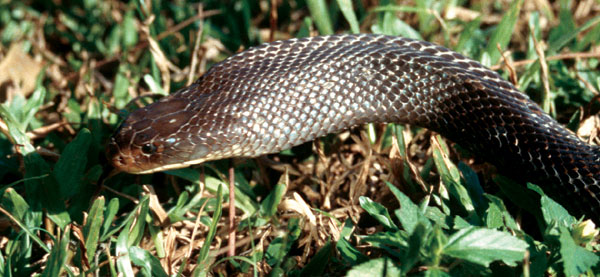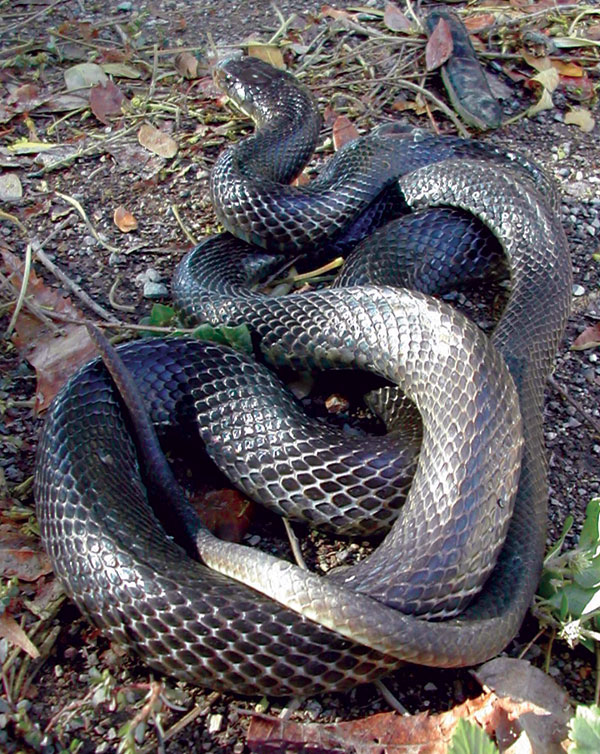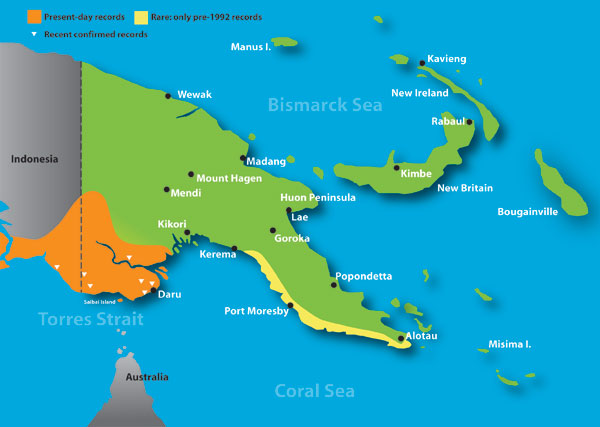toxinologist
Active Member
Hi all,
In response to a special request ... here are some pics of what is possibly one of the world's most endangered and least understood elapids...

Why endangered?
Put simply PNG is facing a Bufo marinus-led ecological disaster on a scale that is unprecedented. Cane toads have been in PNG almost as long as they've been in Australia, but absolutely nothing is being done to halt their invasion. They occur not only in southern PNG from Alotau to the eastern banks of the Fly river, but have also spread along the north coast to well into the Sepik, and even turn up in the PNG Highlands ... not to mention the islands of New Britain and New Ireland where they were first introduced!
Since 1992 there has not been any evidence found to suggest that Papuan blacksnakes Pseudechis papuanus still occur in either Central or Gulf provinces - locations where 30 years ago they were relatively abundant snakes. By no evidence I mean 'no evidence' - no live or dead snakes, or sloughs of blacksnakes have been found despite enormous efforts.
Last year I was very fortunate to capture live specimens in the South Fly district of Western province - which is currently cane toad-free. These photographs were taken during that fieldtrip - which was funded by the Australian Geographic Society - and hopefully a writeup of the trip will appear in a future edition of the AGS Magazine...
Of course cane toads are not the only reason for the decline of this snake. Much of their habitat in Central and Gulf province has been irreversibly changed over the last 30-40 years, and deforestation is certainly a major contributing factor. Some of this habitat loss is due to logging operations, but in the main, most is due simply to PNG's rapidly expanding human population.
Like all blacksnakes, these guys flatten the throat horizontally when threatened ...

My impression is that these very snakes are extremely shy and very flighty. Getting one to sit still for photographs was an enormous challenge, especially when using an 18-35 mm wide-angle lens which necessitates being less than 20 cm from the snake - as in the 1st photograph at the top.
We are currently collecting specimens as part of my research work in PNG, and the hope is to learn something about their biology as well as the intricacies of their venom.

Interestingly, a single specimen of this species has been recorded from Saibai Island - in Australian territory in Torres Strait. Saibai lies just a few kilometres off the coast of PNG's South Fly region to the west of Daru. Whether or not it is common there remains to be determined.
Cheers
David Williams
In response to a special request ... here are some pics of what is possibly one of the world's most endangered and least understood elapids...

Why endangered?
Put simply PNG is facing a Bufo marinus-led ecological disaster on a scale that is unprecedented. Cane toads have been in PNG almost as long as they've been in Australia, but absolutely nothing is being done to halt their invasion. They occur not only in southern PNG from Alotau to the eastern banks of the Fly river, but have also spread along the north coast to well into the Sepik, and even turn up in the PNG Highlands ... not to mention the islands of New Britain and New Ireland where they were first introduced!
Since 1992 there has not been any evidence found to suggest that Papuan blacksnakes Pseudechis papuanus still occur in either Central or Gulf provinces - locations where 30 years ago they were relatively abundant snakes. By no evidence I mean 'no evidence' - no live or dead snakes, or sloughs of blacksnakes have been found despite enormous efforts.
Last year I was very fortunate to capture live specimens in the South Fly district of Western province - which is currently cane toad-free. These photographs were taken during that fieldtrip - which was funded by the Australian Geographic Society - and hopefully a writeup of the trip will appear in a future edition of the AGS Magazine...
Of course cane toads are not the only reason for the decline of this snake. Much of their habitat in Central and Gulf province has been irreversibly changed over the last 30-40 years, and deforestation is certainly a major contributing factor. Some of this habitat loss is due to logging operations, but in the main, most is due simply to PNG's rapidly expanding human population.
Like all blacksnakes, these guys flatten the throat horizontally when threatened ...

My impression is that these very snakes are extremely shy and very flighty. Getting one to sit still for photographs was an enormous challenge, especially when using an 18-35 mm wide-angle lens which necessitates being less than 20 cm from the snake - as in the 1st photograph at the top.
We are currently collecting specimens as part of my research work in PNG, and the hope is to learn something about their biology as well as the intricacies of their venom.

Interestingly, a single specimen of this species has been recorded from Saibai Island - in Australian territory in Torres Strait. Saibai lies just a few kilometres off the coast of PNG's South Fly region to the west of Daru. Whether or not it is common there remains to be determined.
Cheers
David Williams




